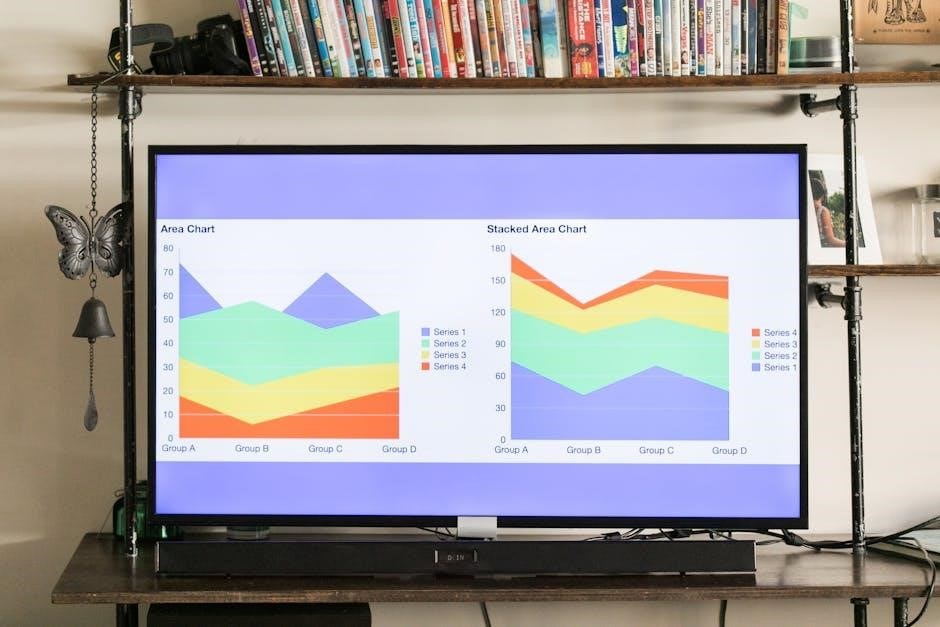The visual display of quantitative information pdf is explained by Edward R. Tufte in his book with 250 illustrations and detailed analysis of data graphics design principles and theory.
Overview of the Book
The book, The Visual Display of Quantitative Information, is a comprehensive guide to the design of data graphics.
The book is written by Edward R. Tufte and published by Graphics Press.
The book provides an overview of the principles of graphical design and how to apply them to the display of quantitative information.
The book is divided into several sections, each focusing on a different aspect of data graphics design.
The book includes 250 illustrations of the best and worst statistical graphics, with detailed analysis of how to display data for precise and effective analysis.
The book is considered a classic in the field of data visualization and is widely used as a reference by designers and researchers.
The book has been updated and revised several times since its initial publication in 1983.
The book is available in pdf format, making it easily accessible to readers around the world.
The book’s content is highly relevant to anyone interested in data visualization and quantitative information display.
The book’s author, Edward R. Tufte, is a renowned expert in the field of data visualization.
The book’s publisher, Graphics Press, is a leading publisher of books on data visualization and related topics.
Author and Publisher Information
The author of the book, The Visual Display of Quantitative Information, is Edward R. Tufte, a renowned expert in the field of data visualization.
The book is published by Graphics Press, a leading publisher of books on data visualization and related topics.
The publisher is located in Cheshire, Connecticut, and can be contacted through their website at www.tufte.com.
The book is copyrighted by Edward R. Tufte, and all rights to the text and illustrations are reserved.
The publisher has made the book available in pdf format, making it easily accessible to readers around the world.
The author and publisher have worked together to produce a high-quality book that is both informative and visually appealing.
The book’s publication date is 1983, and it has been updated and revised several times since then.
The author’s expertise and the publisher’s high standards have resulted in a book that is widely used as a reference by designers and researchers.
The book’s author and publisher information can be found on the book’s website and in the book itself.
The publisher’s website provides additional information about the book and its author.

Key Concepts and Principles
Edward R Tufte explains data graphics design principles and theory in his book.
Graphical Integrity
Graphical integrity is a crucial concept in the visual display of quantitative information, as it refers to the honesty and accuracy of graphical representations of data. According to Edward R. Tufte, graphical integrity is essential to ensure that the graphics are not misleading or deceptive. This concept is closely related to the idea of avoiding graphical deception, which can occur when the graphics are designed to manipulate or distort the data. Tufte argues that graphical integrity can be achieved by following certain principles, such as using clear and concise labels, avoiding unnecessary visual elements, and being transparent about the data sources and methods used. By following these principles, graphical integrity can be maintained, and the graphics can effectively communicate the information to the audience. The importance of graphical integrity is emphasized in Tufte’s book, where he provides examples of graphics that lack integrity and explains how to improve them.

Design Principles
Design principles play a vital role in the visual display of quantitative information, as they guide the creation of effective and informative graphics. Edward R. Tufte’s book emphasizes the importance of design principles in communicating complex data insights. The design principles outlined in the book include the use of high-resolution displays, small multiples, and editing and improving graphics. These principles aim to promote the clear and concise presentation of data, facilitating quick and precise analysis. The book also discusses the role of aesthetics in data graphical displays, highlighting the need for a balance between visual appeal and information accuracy. By applying these design principles, individuals can create graphics that effectively display quantitative information, enabling audiences to understand and engage with the data. The application of design principles is critical in various fields, including social sciences, economics, and natural sciences, where data visualization is essential for research and communication.

Types of Quantitative Displays
Displays include time-series and relational graphics and data maps.
Time-Series and Relational Graphics
Time-series and relational graphics are essential components of the visual display of quantitative information pdf, as discussed by Edward R. Tufte. These graphics help to illustrate trends and relationships between different data points. The use of time-series graphics allows for the display of data over time, making it easier to identify patterns and trends. Relational graphics, on the other hand, help to show the relationships between different variables. By using these types of graphics, individuals can gain a better understanding of the data and make more informed decisions. The visual display of quantitative information pdf provides guidance on how to effectively create and use these graphics. Effective use of time-series and relational graphics can help to improve communication and decision-making. The book provides examples and illustrations of how to apply these graphics in real-world scenarios. By following the principles outlined in the book, individuals can create effective and informative graphics.
Data-Ink Ratio and Aesthetics
The data-ink ratio is a crucial concept in the visual display of quantitative information pdf, as it refers to the proportion of ink used to display actual data versus non-essential ink. According to Edward R. Tufte, a high data-ink ratio is essential for effective communication of data. Aesthetics also play a significant role in the visual display of quantitative information, as a well-designed graphic can engage the viewer and facilitate understanding. The book discusses the importance of balancing aesthetics with functionality, ensuring that the graphic is both visually appealing and informative. The data-ink ratio and aesthetics are closely related, as a high data-ink ratio can contribute to a more aesthetically pleasing graphic. By applying the principles outlined in the book, individuals can create graphics that are both informative and visually appealing, making it easier to communicate complex data insights. Effective use of data-ink ratio and aesthetics can enhance the overall effectiveness of data visualization.

and Applications
The visual display of quantitative information pdf provides a comprehensive guide to effective data visualization, with applications in various fields, including business, academia, and government. The principles outlined in the book can be applied to create informative and engaging graphics, facilitating communication and decision-making. By applying the concepts of graphical integrity, design principles, and data-ink ratio, individuals can create high-quality visualizations that convey complex data insights. The book’s emphasis on aesthetics and functionality ensures that the graphics are both visually appealing and informative. The applications of the visual display of quantitative information are diverse, ranging from scientific research to marketing and finance. Effective data visualization can enhance understanding, facilitate communication, and drive decision-making, making it an essential skill in today’s data-driven world. The book’s principles and concepts can be applied in various contexts, making it a valuable resource for anyone involved in data analysis and visualization.
